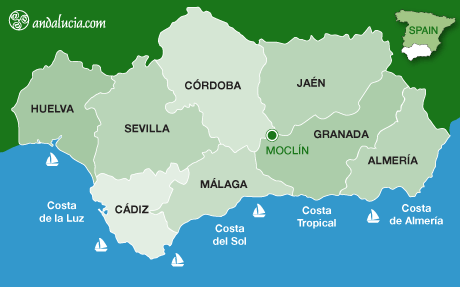Moclin
In the north west of the Granada Province, about 35 kilometres from Granada City, along the N432 towards Cordoba, is the lovely hillside village of Moclín. The situation is hard to beat in terms of historical interest and stunning views from its altitude of 1,065 metres above sea level. It is on the route of the Caliphs and has an impressive 14 th century Moorish Castle looking into the valley. There are breathtaking vistas towards the snow capped Sierra Nevada Mountains as well as down into Granada, home of the famous Alhambra. For a taste of Andalusian village life, this is a good choice as a place to stay when visiting the provinces of Granada and Cordoba. Of great interest in close proximity to the village are many traces of prehistoric man, in the form of cave paintings and Neolithic stone formations. There are approximately 4,750 people living in the municipal district and just over 500 residing in the actual village.
The other villages belonging to the Moclín municipal district are Puerto Lope, Tiena, Tózar, Limones and Los Olivares. Moclín village, where you will find the majority of the historic monuments. These include; The Moclín Castle, fortification walls, the Sanctuary of the Saint Cristo del Paño (from the 16 th century), the Hermitage of San Anton and the Mirador de Moclin.
You will find no grand hotels in this village, but the friendly, family run ‘hostals’ (small hotels or bed and breakfast establishments) are generally very comfortable, clean and affordable. Another option is to rent a village house. You will not meet many English speakers, but the locals are used to welcoming foreign tourists.
History
Prehistoric sites such as the 'Andalusian Neolithic Sanctuary' (Cueva de Malamuerzo) and numerous cave paintings can be found scattered throughout the mountain ranges (Corcuela, Cueva de las Vereas, Bermejas, Araña, etc.). With the rise of Latin culture came the Roman villas of Tiena La Alta and Olivares, as well as the silos of Tózar. However, it was the Hispano-Muslim culture that left the most indelible mark on the area, evident in the imposing fortress that dominates the town of Moclín and the system of watchtowers, receivers and news transmitters towards the capital of the kingdom. More>
Hotels in Moclín
Book Hotels in Moclín
Things to See
Castillo de Moclín
During the Nasrid reign, Moclín Castle was formerly known as 'Hisn Al-Muqlin' (Fortress of the Two Pupils), alluding to its clear role as a permanent sentinel. Dating from the Nasrid period, the castle was built in the mid-fourteenth century using elements from an earlier period. It was constructed as a border castle between the Kingdoms of Granada and Castile. More>
Santuario Cristo del Paño
This is the former parish church of Santa María de la Encarnación, which was founded by the Catholic Monarchs. After being damaged during the Spanish Civil War (1936–1939), it was restored in the twentieth century and used as a church, service chapel and sacristy. The main chapel, designed by Martín Bolívar, was built in the mid-sixteenth century, and the rest of the nave was added later. More>
Casa del Pósito
At the beginning of the Christian town stands the Casa del Pósito, a 16th-century public granary attributed to Pablo de Rojas. Located on Calle Mota. Location>
Centro de Interpretación Comarcal
The Moclín Interpretation Centre houses important local archaeological artefacts. It is located on Calle Saturia Pardo. Location>
Things to See Outside the Town
Iglesia de Nuestra Señora de los Remedios (Puerto Lope)
Puerto Lope had its own jurisdiction and Town Hall in 1824, but these were completely burned down during the Peninsular War The town and its church were lost, but were restored in 1840. The church featured an elegant high altar and a wooden pulpit accessed by a matching staircase, as well as a large marble baptismal font. The church was donated to the town by its owner, Don Eduardo Estrala. More>
Conjunto Arqueológico (Tózar)
The archaeological complex consists of the Mozarabic Necropolis, three tenth-century silos, a prehistoric dolmen known as 'Pileta de la Zorra', a defensive system from the Spanish Civil War (1936) and one of the few remaining Mozarabic farmhouse settlements in Andalusia, dating from the ninth to twelfth centuries. More>
Countryside Walks
Moclín is set in magnificent mountainous scenery, and the local agricultural industry, which involves cultivating cereals and olives, enhances the beauty of the surroundings considerably. There are spectacular walks all around the area, and with numerous superb vantage points overlooking dramatic landscapes. The pine-clad mountainsides are home to an incredible array of flora and fauna, including snakes, genets, owls, eagles and many more.
Some of the routes to explore include Ruta del Gollizo, Vía Ferrata, Ruta de las Atalayas, Ruta de la Fortaleza, Ruta de los Cortijos and Ruta Huellas del Pasado.
Moclin Tours
Book Tours and activities in and around Moclin
Bus Service
There is a bus service from Moclín to Granada City. More>
Gastronomy
The dishes you will be able to sample in the local bars and restaurants are simple home-cooked meals made with fresh, locally sourced ingredients. Try local specialities such as jamón (cured ham), gazpacho (cold tomato soup), puchero (chickpea stew), patatas a lo pobre (fried potatoes and garlic), ajo blanco (cold almond and garlic soup), escabeche de boquerones (anchovy escabeche) and tender local lamb (look for 'cordero' on the menu). For dessert, try the popular arroz con leche de almendra (rice pudding made with almond milk).
Festivals
Popular festivals in Moclín are Día de la Cruz, Romeria del Cristo del Paño, San Antón, San José and San Antonio. More>
Weather Forecast
The weather forecast for the next few days for Moclín. More>
Tourist Office
The tourist office of Moclín is located in the Town Hall. More>
Nearby Places
The neighbouring villages to Moclín are Olivares and Pinos Puente.

